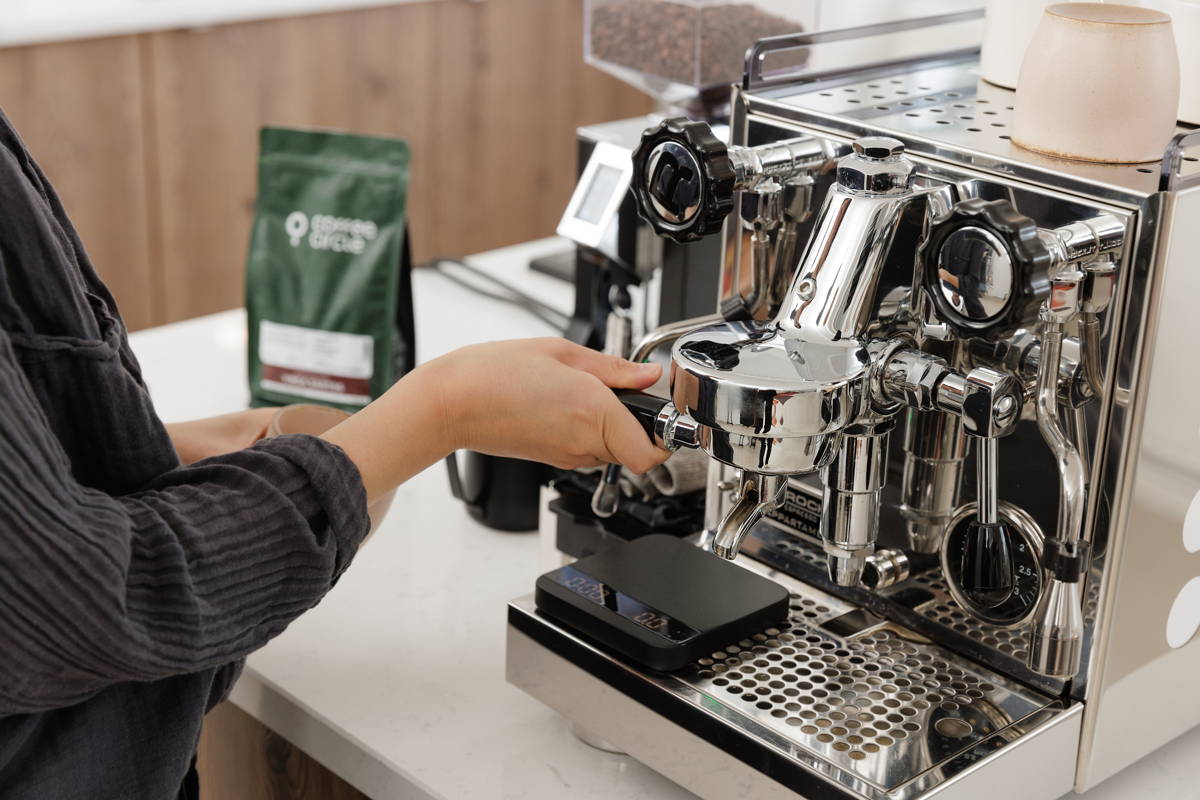
Espresso machines guide
When looking for espresso machines, you often come across confusing technical terms. But what are single-circuit, dual-circuit and dual-boiler machines? And which machine best suits your personal needs?
11 Espresso machines under test
Are you looking for the right machine for you? We present you our test winners.
Which espresso machine is best for me?
To make the drink we all love so much, water is first heated to around 90 °C in a kettle or by means of a instantaneous water heater. It is then pressed through fine ground coffee at a pressure of around 9 bars. The necessary pressure is generated either by a lever or a pump. Since a full-bodied espresso is the basis of many delicious milk drinks, espresso machines almost always also have a steam lance that can be used to produce creamy milk foam. An espresso machine therefore produces hot water for the espresso on the one hand and steam for the milk foam on the other.
Since different processes place different demands on the espresso machine, choosing the right machine starts with a question to yourself:
How often do I want to make milk drinks with my espresso machine?
If your focus is on classic espresso and you only make a cappuccino for Sunday visits, you should look for a single-circuit machine. A dual-circuit is the right choice if you and the rest of the family regularly drink milk-based beverages. The all-rounder among espresso machines is the dual boiler. This type of machine allows you to absolutely optimize your espresso and any milk drinks, but it’s usually only worth it for true perfectionists.
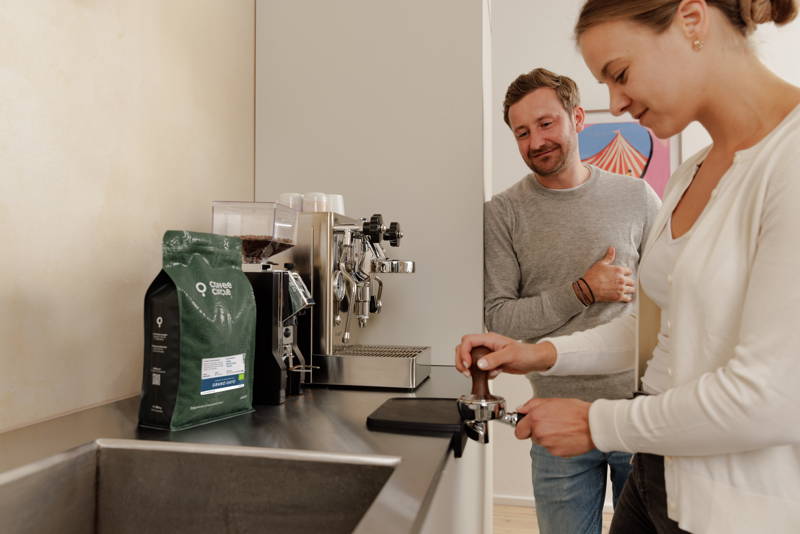
The structure of an espresso machine
Three elements make up an espresso machine: The pump, the boiler (also called boiler or heat exchanger) and the brew group. The design of the boiler and water pipes indicates whether an espresso machine is a single-circuit, dual-circuit or dualboiler.
1. The pump
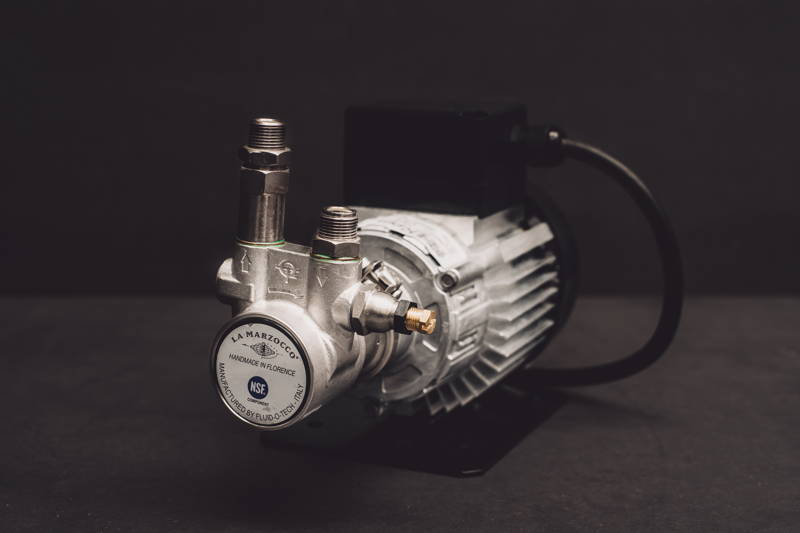
2. The boiler
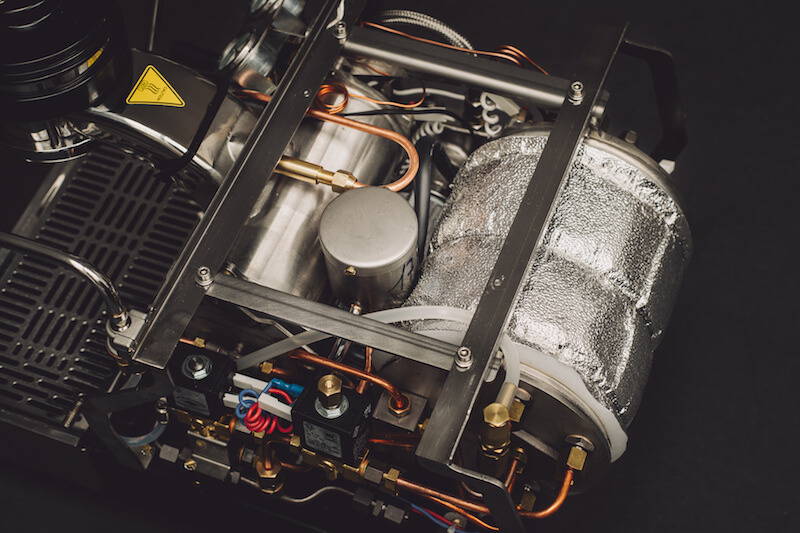
3. The brew group

1. The pump - the driving element
Manufacturers of today’s espresso machines rely mainly on electrically operated pumps. There are two systems, which will be briefly discussed: The vibration pump dominates the segment of household machines, as it is cheaper and takes up less space. According to a comparative test, this variant is in no way inferior in taste to a much more expensive rotary pump. The higher price is justified by the rotary pump’s much higher capacity, which allows it to supply several brewing groups with constant pressure, and by its better robustness and smoothness. Especially due to the latter features, it is also interesting for demanding home baristas.
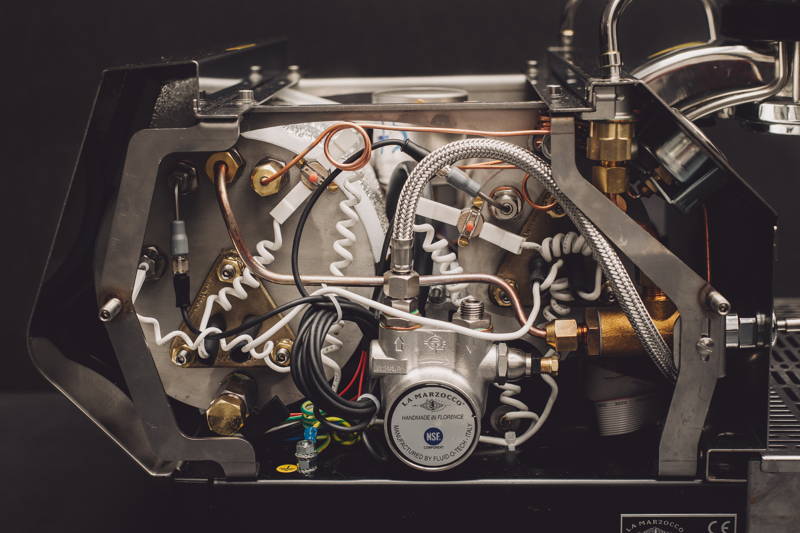
2. The boiler - the heart of an espresso machine
For rough segmentation, let’s look at one of the most important components: The boiler. When choosing, one’s own drinking habits should always be considered: Am I focusing on getting espressos, or do I want to serve milk drinks for myself or even several guests?
The boiler contains the water for brewing the espresso or the steam for foaming the milk. These are brought to the ideal temperature by a heating element, which should be kept as constant as possible – features such as a P. I. D. temperature control or an insulated kettle are particularly helpful here. Another factor is the size of the boiler, which increases the capacity of the water and steam draw.

The different types of machines

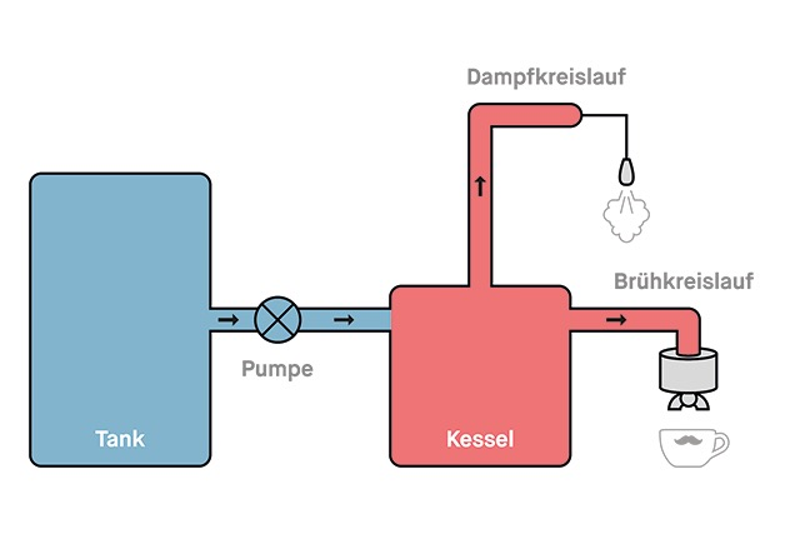
The single-circuit
In single-circuit espresso machines, a single boiler forms the core and supplies the brewing group and steam lance at the same time. This imposes severe restrictions if not only espressos but also milk drinks such as cappuccino or latte macchiato are required. For example, the optimum temperature for the brewing group is around 90 °C, but to create the necessary steam for a velvety milk foam, considerably more than 100 °C is required. Since two different temperatures cannot exist simultaneously in one water circuit, the temperature of the boiler must be adjusted by heating it up when switching from brewing water to steam. Consequently, the resulting waiting time between the two operating modes can be a significant factor in the purchase decision.

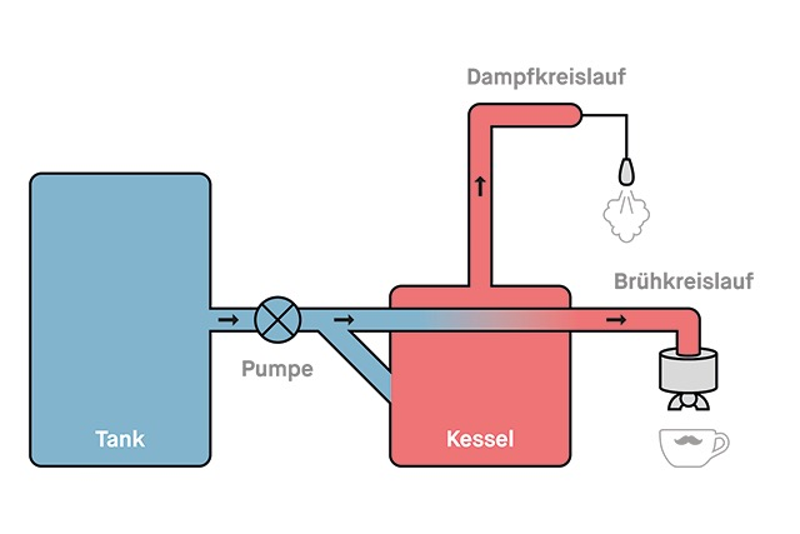
The dual-circuit
The dual-circuit mode of operation avoids this drawback in the preparation of milk beverages. A large boiler with hot water for drawing tea and rich steam for foaming milk forms the first water circuit with temperatures of over 100 °C. This boiler surrounds a small water chamber into which fresh cold water flows from the tank or fixed water connection. As it passes through the much hotter steam boiler, this water heats up to the ideal brewing temperature. This results from the combination of throughput time and ambient temperature. This enables the simultaneous drawing of brewing water and steam without disruptive waiting times. Caution is advised if no espresso is drawn for a longer period of time, as the water in the chamber takes on the temperature of the steam boiler during longer standstills, which is far above the ideal temperature. The best way to solve this problem is to drain water through the brew head. This fills the chamber with fresh cold water before the brewing process.

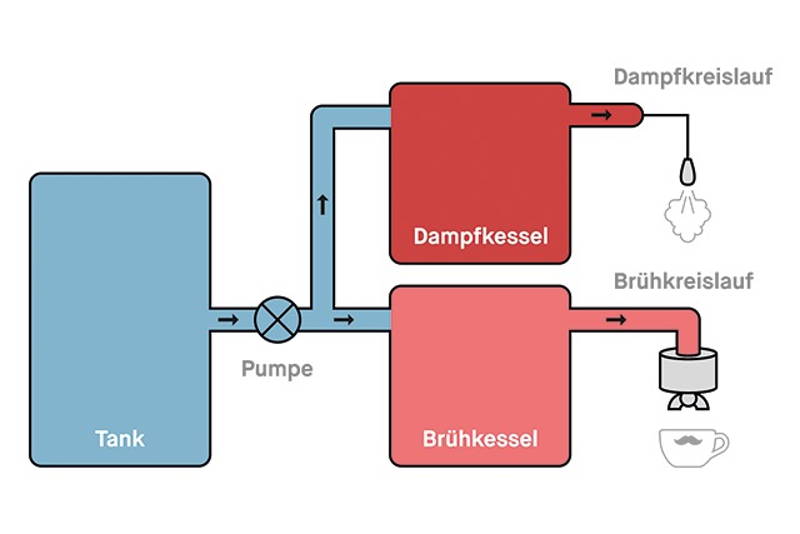
The dual boiler
The dual boiler is a relatively new achievement in the coffee world – two separate boilers for brewing water and steam allow completely new dimensions of capacity and control. Espresso and steam can be drawn almost endlessly and simultaneously from professional dual boiler machines without having to accept fluctuations in pressure or temperature. In addition, the pressure and temperature of both circuits can be adjusted individually.

The thermal block
A thermal block machine works like a coffee machine with an instantaneous water heater. The water flows through a spiral tube embedded in an aluminum block and is heated in the process with the help of a heating rod. Since thermal block machines do not have a boiler, they are ready for use extremely quickly. They also require very little maintenance, as the water is immediately drained from the tube after the espresso has been brewed. Therefore, lime does not have time to deposit on the wall of the tube. Of course, there are also disadvantages. An espresso machine with a thermal block gets very hot, since the thermal block must naturally have a higher temperature to heat the water flowing through it. It does this well at a normal flow rate. If the speed fluctuates due to the density of the puck (compressed coffee grounds in the sieve carrier), the water may come out too cold or too hot. Espresso machines with kettles are more flexible in this regard. Another disadvantage is the steam draw, which can be very slow. Steam is produced by injecting small amounts of water into the spiral, which evaporates immediately. Thus, the steam is usually more watery and has less pressure.
3. The brew group - the last link in the chain
Finally, the brew group determines the quality in the cup. Faema has been setting the standard here since 1961 with the E61 – this consists mainly of three revolutionary elements. A special mechanism consisting of springs and vents allows the remaining pressure to be dissipated after the brewing process. In addition, there is the possibility of pre-infusion, in which hot water at high pressure does not immediately hit the ground coffee, but a small amount of water at low pressure first solidifies the ground coffee and allows it to pre-swell. Finally, there is the element of thermosyphon – here, a water circuit is routed from the boiler through the brew group, ensuring that it is always optimally heated. Only when the water stops for too long due to infrequent espresso use (compare with the dual-circuit brewer) can it overheat and a previous „flush“ is necessary.

Other important terms or functions
Heating time
The espresso machine is not ready for espresso until the brew group is really hot. If you don’t have much time to wait in the morning, run hot water through the brew group to heat it up faster. The heating time depends on the boiler volume and is about 10 – 15 minutes. Espresso machines with thermoblock do not have a boiler and are therefore much faster ready for use, usually after 2-3 minutes.
Automatic shutdown
Occurs when there is a lack of water in the tank. This function is self-explanatory and is particularly useful and effective for machines with smaller water tanks. If there is no water in the tank before using the machine, the boiler may overheat and damage the material.
Boiler
The boiler is the heart of the espresso machine. This is where water is heated for espresso or steam. Depending on the design, an espresso machine has one boiler (single-circuit & dual-circuit) or two boilers (dual boiler). The larger the boiler, the more water/steam is available for espresso. If you only want to drink one espresso in the morning, a small boiler is sufficient. If you like to drink several cappuccinos in the afternoon with friends or family, you should look for a dual boiler with a larger boiler volume. See above for more details.
Vent valve or vacuum valve
In order to achieve the desired water temperature in the boiler, the vent valve closes as soon as the air has escaped the water vapor created in the boiler. Physics can be used to explain why there should be no air in the boiler: If there were a mixture of air and steam, the water temperature would be lower and therefore incorrect at the same pressure than if there were only steam pressure in the boiler.
Expansion valve or pressure relief valve
To ensure that the desired brewing pressure of approx. 9 bar is not exceeded, the expansion valve opens when this pressure is reached and drains off excess water. In this way, it also protects the boiler, the pump and various pipes.
Hysteresis
Hysteresis is often used as a synonym for the range of possible temperatures resulting from the bimetallic thermoswitches in single-circuit boilers. A large hysteresis therefore means a large range of possible boiler temperatures, which would argue for the use of a P. I. D..
Boiler capacity
The kettle size determines how many espressos can be drawn in one go. The larger the kettle, the more water at the same temperature is provided.
Bioler material
Boilers are made of stainless steel, copper, aluminum or brass, with copper and brass boilers having a greater tradition. High-quality copper boilers are mostly installed in dual-circuit and dualboilers. Boilers made of stainless steel are mostly found in single-circuit machines. Really high-end machines also make use of stainless steel boilers or coated copper boilers. Stainless steel is a robust, durable material, it is cheaper to buy than copper or brass, and it can be easily descaled. In comparison, boilers made of aluminum are more critical and must be carefully descaled.
Manometer or pressure gauge
As the name suggests, a pressure gauge provides information about the prevailing pressure at a particular point. Depending on the technical design of a machine, the pressure gauge shows, for example, the boiler pressure or the actual brewing pressure, i.e. the pressure at which the water in the sieve carrier is forced through the coffee grounds.
P.I.D. – Proportional Integral Derivative
P.I.D. are used to control the brewing water temperature in espresso machines, where P, I and D each stand for a separate controller. The P component measures the actual temperature compared to the set temperature and decides whether more heating is required or whether the heating power must be throttled. The I component also includes in its measurement the past time in which the temperature did not correspond to the setpoint temperature and consequently regulates the strength of the heating power. Finally, the D component takes into account other influences on the water temperature, e.g. the inflow of cold water, and additionally dampens or increases the heating power. The three components act together as a PID controller.
Pressostat
The pressostat is a pressure regulator installed in the boiler of two-circuit boilers or in the steam boiler of dual boilers. In the event of a pressure drop, the pressostat causes the heating to switch on and as a result indirectly regulates the temperature.
58 mm sieve carrier
You should also make sure that the sieve carrier of your espresso machine complies with the industry standard of 58 mm. Smaller apertures are often impractical, as they can be filled with a maximum of 14-15 mg of ground espresso and therefore slightly limit your range of tastes. In addition, you will find a wider range of spare parts and tampers for 58 mm.
Conclusion: What you should pay attention to when choosing an espresso machine
When deciding which espresso machine best meets the individual requirements, it is recommended to first sort by the type of boiler. Single-circuit machines are the inexpensive entry into the world of tasty espressos, but they also quickly show their weakness if several cappuccinos are prepared in a short time. Good dual boilers starting at about €1,000 solve the problem. Dual boilers are only worthwhile for real perfectionists or when making numerous hot drinks.
If you’re looking for the right machine for you, check out our espresso machine test. We have tested various machines from all price ranges in detail for you.
Important note The right grinder should have at least the same importance as the espresso machine, because only a consistent grind leads to a good espresso.

Our test winners from the espresso machine test






